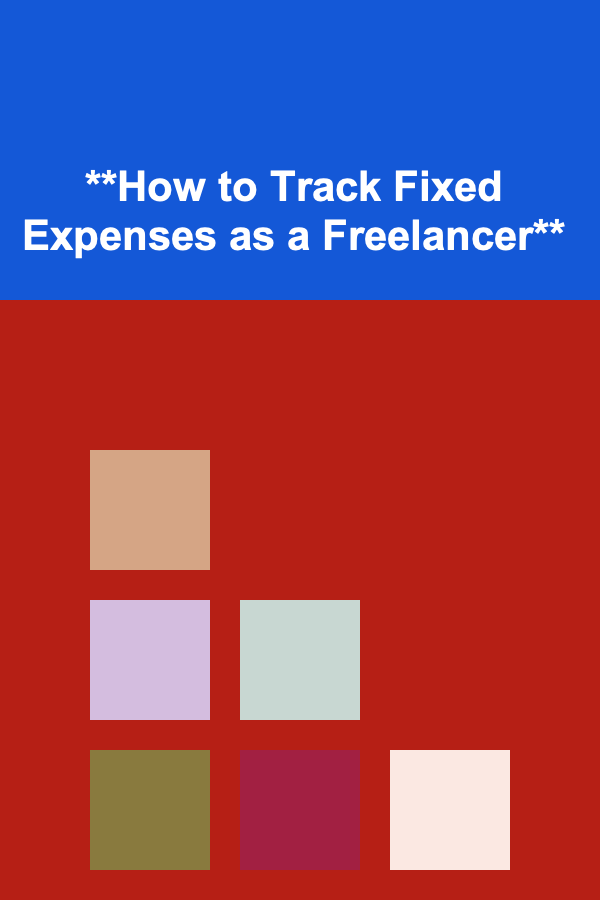
**How to Track Fixed Expenses as a Freelancer**
ebook include PDF & Audio bundle (Micro Guide)
$12.99$9.99
Limited Time Offer! Order within the next:

How to Track Fixed Expenses as a Freelancer
Tracking fixed expenses is a critical part of managing your finances as a freelancer. Unlike traditional employees, freelancers often face fluctuating income, making it essential to have a firm grasp on both variable and fixed costs to ensure financial stability. Fixed expenses are predictable costs that stay the same each month, such as rent, utilities, subscriptions, or loan repayments.
In this article, we will explore practical methods to track your fixed expenses effectively, enabling you to create a sustainable and reliable financial plan.
What Are Fixed Expenses?
Before delving into the techniques for tracking fixed expenses, it's essential to understand what these expenses are. Fixed expenses are regular, recurring payments that typically do not change from month to month. Examples of fixed expenses for freelancers include:
- Rent or Mortgage Payments: If you have an office space or rent an apartment to live in, these costs are usually fixed on a monthly basis.
- Utility Bills: While there may be minor fluctuations, utilities like electricity, water, internet, and phone services usually have consistent monthly costs.
- Insurance Premiums: Health insurance, business insurance, car insurance, and other forms of coverage are typically billed on a regular basis.
- Subscription Services: Software tools like Adobe Creative Cloud, accounting software, and other necessary subscriptions for your business fall into this category.
- Loan Repayments: Any loan repayment for education, business expenses, or personal loans that you pay regularly.
- Taxes: While the amount may vary depending on your earnings, you may have consistent monthly or quarterly payments for estimated taxes.
- Retirement Contributions: If you have a retirement plan in place, such as a 401(k) or IRA, these contributions are regular and predictable.
Understanding these expenses is essential to help you manage your money and ensure that your business remains profitable.
Why Tracking Fixed Expenses Is Important
As a freelancer, you may experience fluctuations in your monthly income due to project delays, seasonal variations, or clients' payment schedules. Having a clear picture of your fixed expenses enables you to:
- Create a Budget: Understanding your fixed costs allows you to budget effectively and set aside enough funds for these regular payments.
- Ensure Cash Flow Stability: Knowing when fixed expenses are due helps you avoid late fees and ensures that you have enough savings to cover costs, even in lean months.
- Plan for Tax Liabilities: Accurately tracking fixed expenses can help you plan for tax deductions and ensure that your expenses are accounted for during tax season.
- Save for Emergencies and Investments: By understanding your fixed expenses, you can better allocate funds toward savings, emergency funds, and investments.
Tools for Tracking Fixed Expenses
As a freelancer, you have several options when it comes to tracking your fixed expenses. Using the right tools can help streamline the process and reduce the chance of forgetting a payment. Below are some tools you can utilize to keep track of your fixed expenses:
1. Spreadsheet Software (Google Sheets or Excel)
For freelancers who prefer manual tracking, spreadsheet software like Google Sheets or Microsoft Excel is an effective way to monitor fixed expenses. These tools allow you to set up custom templates that track both fixed and variable expenses. Here's how you can set it up:
- Create Columns for Each Category: Include categories like rent, utilities, subscriptions, and loans.
- Track Monthly Payments: Input the amounts for each expense and update the spreadsheet as bills are paid.
- Automate Calculations: Use formulas to calculate totals and track your spending each month.
- Set Reminders: Use the built-in calendar or set up notifications to remind you of upcoming payments.
Spreadsheets are a low-cost and customizable solution that can be adapted to fit any freelancer's needs. However, they require regular attention and may not be as efficient as other automated tools.
2. Expense Tracking Apps (Mint, YNAB, PocketGuard)
For freelancers who want a more automated solution, there are several expense tracking apps that can help manage fixed expenses efficiently. Some popular apps include:
- Mint: Mint is a free app that automatically imports your financial transactions and categorizes your expenses. You can set up budget categories for your fixed expenses and receive alerts for upcoming payments. It also offers insights into your spending patterns and helps you plan for savings goals.
- YNAB (You Need a Budget): YNAB is a paid budgeting tool designed to help you track your expenses and give every dollar a job. It's particularly useful for freelancers because it helps you account for irregular income and set aside funds for fixed expenses like taxes and insurance.
- PocketGuard: This app tracks your spending and provides a clear overview of your available cash after accounting for fixed expenses, bills, and savings goals. It's especially useful for tracking recurring costs.
These apps can help automate much of the process, ensuring that you stay on top of your expenses without having to manually enter data each time.
3. Accounting Software (QuickBooks, FreshBooks, Xero)
If you're managing a significant number of clients and want a more comprehensive solution for your business, accounting software like QuickBooks, FreshBooks, or Xero can be invaluable tools. These platforms offer a wide range of features, including:
- Expense Tracking: Automatically import and categorize your fixed expenses from your bank and credit accounts.
- Invoicing and Payments: Send invoices to clients and track your income, ensuring that it aligns with your fixed expenses.
- Tax Calculation: Track tax liabilities based on your expenses and income, making tax season easier.
- Profit and Loss Reports: Get a clear understanding of how your fixed expenses affect your bottom line, which can help you make more informed business decisions.
Accounting software can be particularly useful for freelancers with multiple income streams or for those who want to ensure they have a full financial overview of their business.
4. Banking Apps with Bill Pay Features
Many banks offer apps that allow you to track your spending, set up bill payments, and get reminders for upcoming due dates. Apps such as:
- Chase Mobile App: Allows you to set up automatic bill payments and track recurring charges, helping you ensure that your fixed expenses are paid on time.
- Wells Fargo Bill Pay: Offers similar functionality, with the added bonus of sending reminders for upcoming payments and the option to schedule payments in advance.
Using your bank's app can be a convenient and secure way to track your fixed expenses, especially if you have your bills set to be paid automatically from your account.
Tips for Effectively Managing Fixed Expenses
While tracking your fixed expenses is essential, there are several strategies you can employ to manage them efficiently:
1. Automate Your Payments
Where possible, set up automatic payments for your fixed expenses. Many service providers, such as landlords, insurance companies, and utilities, offer auto-pay options. This ensures that you never miss a payment and can avoid late fees. Just make sure to monitor your account regularly to ensure there are no issues.
2. Create a Dedicated Expense Account
Consider opening a separate bank account specifically for business or fixed expenses. By transferring a fixed amount of money into this account each month, you can ensure that you have enough to cover your recurring costs without having to dip into your variable income.
3. Review Your Expenses Periodically
Even though fixed expenses tend to be predictable, it's essential to review them periodically to make sure they remain in line with your budget. Check for any changes in subscription rates, insurance premiums, or service fees. If you find areas where costs can be reduced (e.g., switching to a more affordable software plan), take action to optimize your spending.
4. Set Aside Emergency Funds for Fixed Expenses
As a freelancer, you may have months where your income is lower than usual. Having an emergency fund specifically for fixed expenses will give you peace of mind during lean months, ensuring you have the funds available to cover your essential costs.
5. Stay Organized
Keep all receipts, contracts, and payment schedules for your fixed expenses organized. Whether you store them digitally or physically, having easy access to these documents will help you manage your expenses and stay on top of your financial obligations.
Conclusion
Tracking fixed expenses is a key part of financial management for freelancers. By understanding and organizing these expenses, you can maintain financial stability, ensure you never miss a payment, and plan effectively for both the short and long term. Whether you use spreadsheets, expense tracking apps, or accounting software, finding a system that works for you will help you stay on top of your finances and keep your business running smoothly. By implementing these strategies, you'll have the peace of mind that comes with knowing your fixed expenses are managed and under control.
Reading More From Our Other Websites
- [Biking 101] The Ultimate Guide to Tandem Bikes: Features, Setup, and Maintenance
- [Home Cleaning 101] How to Choose and Use Pet-Friendly Cleaning Products for a Safe Home
- [Home Renovating 101] How to Save Money on Home Renovations by Doing It Yourself
- [Organization Tip 101] How to Maintain a Tidier Bedroom on a Budget
- [Organization Tip 101] How to Organize Your Podcast Library for Easy Listening
- [Ziplining Tip 101] Glide Into a New Beginning: How Ziplining Sparks Fresh Starts
- [Home Lighting 101] How to Choose the Perfect Light Bulb for Every Room's Needs
- [Star Gazing Tip 101] Beginner's Guide: Choosing the Perfect Telescope for Star Gazing Adventures
- [Weaving Tip 101] From Thread to Treasure: A Step-by-Step Guide to Weaving Your First Scarf
- [Organization Tip 101] How to Create a Home Inventory for Insurance Purposes

How to Maintain a Clutter-Free Craft Area
Read More
How to Make Money Online as a Biomedical Engineer? 10 Actionable Ideas
Read More
How to Organize Your Craft Room with Multi-Functional Furniture
Read More
How to Organize Your Jewelry Collection for Easy Access
Read More
How to Leverage Dark Social for Insights
Read More
Dating as an Extrovert: A Comprehensive Guide
Read MoreOther Products

How to Maintain a Clutter-Free Craft Area
Read More
How to Make Money Online as a Biomedical Engineer? 10 Actionable Ideas
Read More
How to Organize Your Craft Room with Multi-Functional Furniture
Read More
How to Organize Your Jewelry Collection for Easy Access
Read More
How to Leverage Dark Social for Insights
Read More